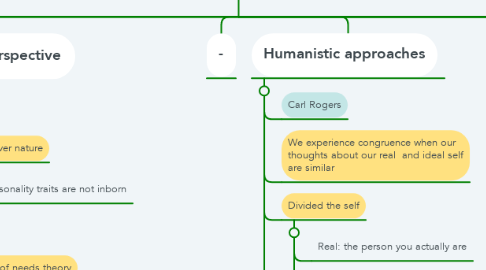
1. -
2. -
3. -
4. Psychodynamic perspective Freud
4.1. Stages of psychosexual development
4.1.1. Oral 0-1
4.1.2. Anal 1-3
4.1.3. Phallic (genital) 3-6
4.1.4. Latency (none) 6-12
4.1.5. Genial +12
4.2. Unconscious
4.3. EGO
4.3.1. Id & superego
4.4. Defense Mechanisms
4.4.1. Denial
4.4.2. Displacement
4.4.2.1. Low:uncooperative
4.4.3. Projection
4.4.4. Rationalization
4.4.5. Reaction formation
4.4.6. Regression
4.4.7. Repression
4.4.8. Sublimation
4.4.9. Sublimation
5. Neo-Freudians
5.1. Adler
5.1.1. Superiority complex
5.1.2. Social tasks
5.1.2.1. Societal tasks
5.1.2.2. Love tasks
5.1.2.3. Occupational tasks
5.2. Inferiority complex
5.3. Erikson
5.3.1. Personality is developed throughout your life
5.3.2. Stages of psychosocial crisis
5.3.2.1. Autonomy vs shame (will) 1-3
5.3.2.2. Initiative vs Guilt (purpose) 3-5
5.3.2.2.1. Industry vs inferiority (competency )5-12
5.3.2.2.2. Identity vs role confusion (fidelity) 12-18
5.3.2.3. Intimacy vs isolation (love) 18-40
5.3.2.4. Generativity vs stagnation (care ) 40-65
5.3.2.5. Ego integrity vs despair (wisdom) 65+
5.3.2.6. Trust vs mistrust (hope) 0-1
5.3.3. Interpersonal relationship are more important tan sexual energy
5.4. Jung
5.4.1. The collective unconscious is a universal version of the unconscious
5.4.1.1. Mental patterns or memory traces
5.4.1.1.1. These ancestral memories are called archetypes
5.4.2. 2 attitudes or approaches towards life
5.4.2.1. Introversion
5.4.2.2. Extroversion
5.4.3. The focus of analytics of psychology is on working to balance opposing forces of conscious and unconscious thought and experience within ones personality
5.5. Horney
5.5.1. Each individual has the potential for self realization
5.5.1.1. Coping styles
5.5.1.1.1. Moving against people
5.5.1.1.2. Moving away from people
5.5.1.1.3. Moving toward people
6. Biological approaches
6.1. Minessota
6.1.1. Twins even when we are separated that have pretty similar personalities
6.2. Somatoypes
6.2.1. Endomorph
6.2.1.1. Average size bones, solid torso, low levels of fat, sociable and fun
6.2.2. Mesomorph
6.2.2.1. Equilibrarse body of muscles and bones. Energetic and like sports
6.2.3. Ectomorph
6.2.3.1. Tall, thin, emotional and with social problems.
7. Traits approaches
7.1. The five factor model (OCEAN)
7.1.1. Oppenes
7.1.1.1. High: curious and independent
7.1.1.2. Low: impulsive and conventional
7.1.2. Conscientiousness
7.1.2.1. High: organized and hardworking
7.1.2.2. Low: impulsive careless
7.1.3. Extroversion
7.1.3.1. Low: quiet, reserves
7.1.3.2. High: outgoing, warm
7.1.3.3. High: outgoing, warm
7.1.4. Agreeableness
7.1.5. High: helpful and emphatic
7.1.6. Neuroticism
7.1.6.1. High: anxious, unhappy
7.1.6.2. Low: Calm, secure
8. Cultural understandings
8.1. Universal
8.1.1. Some personality traits don’t depend on culture
8.2. Culture- specific
8.2.1. Asian: collectivism
8.2.2. Central and South African: openness 
8.2.3. European: neuroticism
8.2.4. Indigenous
8.2.5. Indigenous
8.3. South approaches
8.3.1. Cultural-comparative
8.3.2. Combiness
9. Behavioral perspective
9.1. Skinner
9.1.1. Nurture over nature
9.1.1.1. Personality traits are not inborn
9.2. Maslow
9.2.1. Hierarchy of needs theory
9.2.1.1. Self actualization e
9.2.1.2. Esteem needs
9.2.1.3. Love needs
9.2.1.4. Safety needs
9.2.1.5. Physiological needs
9.2.1.5.1. People were motivated by feelings of inferiority in childhood
9.3. Behave on prior learning
9.3.1. Behave in certain way
9.3.2. Theory of birth order
9.3.2.1. The youngest will be spoiled
9.3.2.2. The middle ones will help get both along
9.3.2.3. Older siblings will be overachievers
9.3.3. Personality develops over our entire life not only the first few years
9.3.3.1. Increasing the ones that lead to positive results
9.4. Bandura (social-cognitive )
9.4.1. Reciprocal determinism
9.4.2. Observational learning
9.4.2.1. Personality is shaped by actions
9.4.3. Learning new behavior patterns when we see others performing them
9.4.4. Decrease the ones that don’t
9.4.5. Self efficacy
10. Humanistic approaches
10.1. Carl Rogers
10.2. We experience congruence when our thoughts about our real and ideal self are similar
10.3. Divided the self
10.3.1. Real: the person you actually are
10.3.2. Ideal: the person you would like to be
10.4. Masloww
11. -
12. -
13. Historical perspective
13.1. Franz Gall
13.1.1. Proposed that: distance between bumps on the skull reveals personality traits
13.1.1.1. Phrenology
13.2. Hippocrates
13.2.1. Human behaviors are based in 4 temperaments
13.2.1.1. Choleric (yellow liver)
13.2.1.2. Sanguine (red-heart)
13.2.1.3. Melancholic( black liver)
13.2.1.4. Phlegmatic(white-lung)

